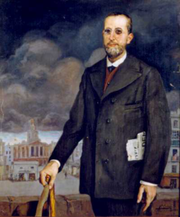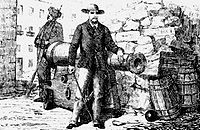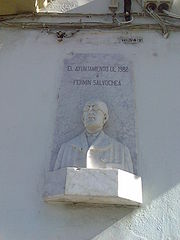
Fermín Salvochea
Encyclopedia

Cádiz
Cadiz is a city and port in southwestern Spain. It is the capital of the homonymous province, one of eight which make up the autonomous community of Andalusia....
- 27 September 1907, Cádiz) was a mayor of the city of Cádiz
Cádiz
Cadiz is a city and port in southwestern Spain. It is the capital of the homonymous province, one of eight which make up the autonomous community of Andalusia....
and a president of the province of Cádiz
Cádiz (province)
Cádiz is a province of southern Spain, in the southwestern part of the autonomous community of Andalusia, the southernmost part of continental Western Europe....
. He was one of the main propagators of anarchist
Anarchism
Anarchism is generally defined as the political philosophy which holds the state to be undesirable, unnecessary, and harmful, or alternatively as opposing authority in the conduct of human relations...
thought in that area in the late 19th century and is considered to be "perhaps the most beloved figure in the Spanish Anarchist
Anarchism in Spain
Anarchism has historically gained more support and influence in Spain than anywhere else, especially before Francisco Franco's victory in the Spanish Civil War of 1936–1939....
movement of the 19th century". Being a prominent republican
Federal republicanism
Federal republicanism is an ideology, prevalent mainly in the 19th century Spain, which incorporates republicanism and advocates local associations of citizens and promotes citizen participation in public affairs...
, in 1871, he joined the First International. In 1873, he was elected president of the administrative committee of Cádiz Province.
Ideologically, he was influenced by Bradlaugh
Charles Bradlaugh
Charles Bradlaugh was a political activist and one of the most famous English atheists of the 19th century. He founded the National Secular Society in 1866.-Early life:...
, Owen
Robert Owen
Robert Owen was a Welsh social reformer and one of the founders of utopian socialism and the cooperative movement.Owen's philosophy was based on three intellectual pillars:...
and Paine
Thomas Paine
Thomas "Tom" Paine was an English author, pamphleteer, radical, inventor, intellectual, revolutionary, and one of the Founding Fathers of the United States...
, whose works he had studied during his stay in England
England
England is a country that is part of the United Kingdom. It shares land borders with Scotland to the north and Wales to the west; the Irish Sea is to the north west, the Celtic Sea to the south west, with the North Sea to the east and the English Channel to the south separating it from continental...
, and Kropotkin
Kropotkin
Peter Kropotkin was a Russian prince and anarchist.Kropotkin may also refer to:*Pyotr Nikolayevich Kropotkin , Soviet/Russian geologist, tectonician, and geophysicist*Mount Kropotkin, a peak in Antarctica...
, whom he read later. In Spain
Spain
Spain , officially the Kingdom of Spain languages]] under the European Charter for Regional or Minority Languages. In each of these, Spain's official name is as follows:;;;;;;), is a country and member state of the European Union located in southwestern Europe on the Iberian Peninsula...
he had contact with the anarchist thinkers and members of the Bakuninist Alliance, including Anselmo Lorenzo
Anselmo Lorenzo
Anselmo Lorenzo was a defining figure in the early Spanish Anarchist movement, earning the oft quoted sobriquet "the grandfather of Spanish anarchism," in the words of Murray Bookchin; "his contribution to the spread of Anarchist ideas in Barcelona and Andalusia over the decades was enormous"...
and Francisco Mora
Francisco Mora
Francisco Mora was born in 1922 in the central-western state of Michoacán His father was a weaver, musician, and Mexican artist. In 1941, Mora relocated to Mexico City where he began exhibiting with the Taller de Gráfica Popular, a communal graphics workshop founded by artists Leopold Méndez, Pablo...
.
Biography

Juan Álvarez Mendizábal
Juan Álvarez Mendizábal, born Juan Álvarez Méndez , was a Spanish economist and politician....
.
At the age of 15 his father, following the traditions of the mercantile bourgeoisie of Cádiz to which they belonged, sent him to England to become familiar with the ways of commerce. Fermín stayed in London
London
London is the capital city of :England and the :United Kingdom, the largest metropolitan area in the United Kingdom, and the largest urban zone in the European Union by most measures. Located on the River Thames, London has been a major settlement for two millennia, its history going back to its...
and Liverpool
Liverpool
Liverpool is a city and metropolitan borough of Merseyside, England, along the eastern side of the Mersey Estuary. It was founded as a borough in 1207 and was granted city status in 1880...
for five years. But he was more devoted to studying the social problems of the time than the mercantile trade. He read the works of Owen
Robert Owen
Robert Owen was a Welsh social reformer and one of the founders of utopian socialism and the cooperative movement.Owen's philosophy was based on three intellectual pillars:...
, Paine
Thomas Paine
Thomas "Tom" Paine was an English author, pamphleteer, radical, inventor, intellectual, revolutionary, and one of the Founding Fathers of the United States...
and Berdlow. He returned to Cádiz at 21, with a yearning to reform society, influenced by the doctrines of utopian socialism
Utopian socialism
Utopian socialism is a term used to define the first currents of modern socialist thought as exemplified by the work of Saint-Simon, Charles Fourier, and Robert Owen which inspired Karl Marx and other early socialists and were looked on favorably...
. He was also known for his tolerance and generosity.
After the Glorious Revolution
Glorious Revolution (Spain)
The Glorious Revolution took place in Spain in 1868, resulting in the deposition of Queen Isabella II.An 1866 rebellion led by General Juan Prim and a revolt of the sergeants at San Gil barracks, in Madrid, sent a signal to Spanish liberals and republicans that there was serious unrest with the...
, he was appointed head of one of the Battalions of Voluntarios de la Libertad in Cádiz. Actively participating in the revolution of 1868 in Cádiz
Cádiz
Cadiz is a city and port in southwestern Spain. It is the capital of the homonymous province, one of eight which make up the autonomous community of Andalusia....
, he was imprisoned. Released in 1869 he organized armed resistance against the government in the Sierra de Cádiz
Sierra de Cádiz
Sierra de Cádiz is a comarca province of Cádiz .Most of the comarca's territory is within the Sierra de Grazalema Natural Park, a protected area....
. But after being defeated by the government troops, he took refuge in Gibraltar
Gibraltar
Gibraltar is a British overseas territory located on the southern end of the Iberian Peninsula at the entrance of the Mediterranean. A peninsula with an area of , it has a northern border with Andalusia, Spain. The Rock of Gibraltar is the major landmark of the region...
. In 1871, thanks to the amnesty granted by Amadeo of Savoy, he returned to Cádiz. It is believed that it was at this time when he joined the First International, and he continued to support Republican ideas.
Being the leader of the Canton of Cádiz
Cádiz (province)
Cádiz is a province of southern Spain, in the southwestern part of the autonomous community of Andalusia, the southernmost part of continental Western Europe....
at the end of Cantonal revolution
Cantonal Revolution
The Cantonal Revolution was a cantonalist uprising that took place during the First Spanish Republic, starting on July 12 of 1873 in Cartagena...
, he was captured by the troops of General Pavia
Manuel Pavía y Rodríguez de Alburquerque
Manuel Pavia y Rodriguez de Alburquerque was a Spanish general, born in Cadiz. He was the son of Admiral Pavia, a naval officer of some note in the early part of the 19th century....
in Seville
Seville
Seville is the artistic, historic, cultural, and financial capital of southern Spain. It is the capital of the autonomous community of Andalusia and of the province of Seville. It is situated on the plain of the River Guadalquivir, with an average elevation of above sea level...
, tried and sentenced to life imprisonment. He remained for several years in detention in La Gomera
La Gomera
La Gomera is one of Spain's Canary Islands, located in the Atlantic Ocean off the coast of Africa. In area, it is the second-smallest of the seven main islands of this group.- Political organization :...
and Ceuta
Ceuta
Ceuta is an autonomous city of Spain and an exclave located on the north coast of North Africa surrounded by Morocco. Separated from the Iberian peninsula by the Strait of Gibraltar, Ceuta lies on the border of the Mediterranean Sea and the Atlantic Ocean. Ceuta along with the other Spanish...
. After refusing the pardon that he was granted by the council of Cádiz in 1883, he escaped to Morocco
Morocco
Morocco , officially the Kingdom of Morocco , is a country located in North Africa. It has a population of more than 32 million and an area of 710,850 km², and also primarily administers the disputed region of the Western Sahara...
. Disenchanted by politics and parliamentarianism, it was during his years in prison and in exile (after his escape which took him to France), when he firmly became an anarchist of the anarchist communism
Anarchist communism
Anarchist communism is a theory of anarchism which advocates the abolition of the state, markets, money, private property, and capitalism in favor of common ownership of the means of production, direct democracy and a horizontal network of voluntary associations and workers' councils with...
school.
Upon the death of Alfonso XII he was granted amnesty again and he returned to Cádiz, where he founded the newspaper El Socialismo, which published, among other items, the anarchist communist ideas of Kropotkin
Kropotkin
Peter Kropotkin was a Russian prince and anarchist.Kropotkin may also refer to:*Pyotr Nikolayevich Kropotkin , Soviet/Russian geologist, tectonician, and geophysicist*Mount Kropotkin, a peak in Antarctica...
, thus introducing anarcho-communist thinking among the Spaniards, many of whom were still attached to the collectivist anarchism
Collectivist anarchism
Collectivist anarchism is a revolutionary doctrine that advocates the abolition of both the state and private ownership of the means of production...
. He thus encouraged internal debate. He organized the first May Day
May Day
May Day on May 1 is an ancient northern hemisphere spring festival and usually a public holiday; it is also a traditional spring holiday in many cultures....
in Cádiz in 1890, which was then followed as a custom during the following years. He was again thrown in jail after the Agrarian Mutiny of Jerez de la Frontera, in 1892, thanks to a false testimony that caused him to be sentenced to 12 years in prison. An amnesty allowed him out of prison in 1899, and he returned again to Cádiz (where he met Pedro Vallina), and then soon departed to Madrid. Both of them worked with the magazine, La Revista Blanca
La Revista Blanca
La Revista Blanca was a Spanish individualist anarchist magazine of sociology and arts published in Madrid by Joan Montseny y Teresa Mañé from 1898 to 1905 and in Barcelona from June 1, 1923 till August 15, 1936....
run by the libertarians Joan Montseny
Joan Montseny
Joan Montseny i Carret was a Catalan anarchist....
and Soledad Gustavo, and generally participated in the anarchist activities of the capital. He was present at and supported the general strike of 1902.
During his life, he often renounced his heritage and family possessions and delivered it to the most needy. He lived in destitution and away from material luxury.
Back in Cádiz, his last work was a translation of Kropotkin's Fields, Factories and Workshops
Fields, Factories and Workshops
Fields, Factories and Workshops: or Industry Combined with Agriculture and Brain Work with Manual Work is a landmark anarchist text by Peter Kropotkin, and arguably one of the most influential and positive statements of the anarchist political philosophy. It is viewed by many as the central work of...
. He died on 28 September 1907, after falling from the table that was serving as his bed. His funeral was a great demonstration of popular grief with about fifty thousand people, mostly workmen from the Cádiz
Cádiz
Cadiz is a city and port in southwestern Spain. It is the capital of the homonymous province, one of eight which make up the autonomous community of Andalusia....
and Jerez areas, in attendance.
Legacy

The anarchist historian Manuel Buenacasa Tomeo
Manuel Buenacasa Tomeo
Manuel Buenacasa Tomeo was a Spanish trade unionist and anarchist and a militant of the Confederación Nacional del Trabajo....
called Salvochea "nuestro santo mayor" - "our greatest saint". His image as a "saintly" figure is in contrast to some of the other elements in the anarchist movement like Paulino Pallás who employed more terroristic tactics.
Cultural image
Blasco Ibáñez created a character based on Salvochea in his novel "La Bodega", called Fernando Salvatierra. During the Second Spanish RepublicSecond Spanish Republic
The Second Spanish Republic was the government of Spain between April 14 1931, and its destruction by a military rebellion, led by General Francisco Franco....
, while the people of Cádiz were discussing the erection of a monument in his honor, a village in the province of Huelva named itself after Salvochea. In the early parts of the Spanish Civil War
Spanish Civil War
The Spanish Civil WarAlso known as The Crusade among Nationalists, the Fourth Carlist War among Carlists, and The Rebellion or Uprising among Republicans. was a major conflict fought in Spain from 17 July 1936 to 1 April 1939...
, one of the columns that fought in Aragon was named after him. In 1980, the democratic council of Cádiz, dedicated a street and a bust to Salvochea. He figures on a recurring basis, from local traditions, in the Carnival in the city of Cádiz. A fraction of the Cádiz CF
Cádiz CF
Cádiz Club de Fútbol, S.A.D. is a Spanish football team based in Cádiz, in the autonomous community of Andalusia. Founded in 1910, it currently plays in Segunda División B - Group 4, holding home games at Estadio Ramón de Carranza, with a 22,000-seat capacity.Salvadoran legend Mágico González, who...
calls itself the "Salvochea Column". At present, the Ateneo Libertario, an institute of secondary education, and a neighborhood association bear his name in Cádiz. To this day, flowers are placed on his grave in Cádiz.
After his death, he was popularly known, in antithesis to the Catholicism dominant in that region, as "The Saint of Anarchy."
Further reading
- Iñiguez, Miguel: "Enciclopedia histórica del anarquismo español", Asociación Isaac Puente, Vitoria, 2008.

